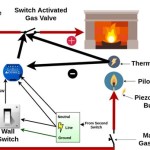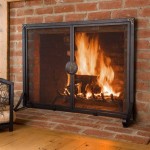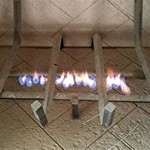Patio Gas Fireplace: Enhancing Outdoor Living Spaces
A patio gas fireplace serves as a focal point and heat source for outdoor living spaces, extending the usability of patios, decks, and other outdoor areas beyond the warmer months. These fireplaces, fueled by propane or natural gas, offer a convenient and controllable alternative to traditional wood-burning fireplaces. They eliminate the need for wood storage, chopping, and the associated cleanup, while providing instant warmth and ambiance.
The versatility of patio gas fireplaces is evident in the diverse range of designs and styles available. Models range from portable fire pits to built-in structures, allowing homeowners to select an option that complements their existing outdoor décor and meets their specific heating needs. Furthermore, modern patio gas fireplaces often incorporate safety features and advanced control systems, ensuring both user-friendliness and peace of mind.
The choice between propane and natural gas depends on factors such as access to a natural gas line and personal preferences regarding fuel storage and convenience. Propane-fueled fireplaces provide greater portability, as they can be connected to a portable propane tank. Natural gas fireplaces, on the other hand, require a permanent connection to a natural gas line, offering an uninterrupted fuel supply.
Key Benefits of Patio Gas Fireplaces
Patio gas fireplaces present several advantages over traditional wood-burning fireplaces, making them a popular choice for outdoor heating and ambiance. These benefits encompass convenience, ease of use, environmental considerations, and aesthetic appeal.
One of the primary advantages is the instant ignition and adjustable flame control offered by gas fireplaces. Unlike wood-burning fireplaces, which require time to build a fire and maintain a consistent flame, gas fireplaces ignite with the push of a button and allow users to easily adjust the flame height and heat output. This level of control provides greater comfort and convenience, particularly on evenings with fluctuating temperatures.
Furthermore, gas fireplaces eliminate the need for wood storage and handling. Wood-burning fireplaces require a significant amount of space for wood storage, as well as the effort of chopping, stacking, and carrying wood. Gas fireplaces, on the other hand, require no such preparation, simplifying the process of enjoying a fire. This is particularly appealing to homeowners with limited storage space or physical limitations.
From an environmental perspective, gas fireplaces are generally considered cleaner than wood-burning fireplaces. They produce fewer emissions and particulate matter, reducing air pollution and minimizing the impact on the surrounding environment. While gas is still a fossil fuel, the controlled combustion and cleaner burning properties of modern gas fireplaces contribute to a more environmentally responsible heating option compared to traditional wood fires.
The aesthetic appeal of patio gas fireplaces is another significant advantage. Available in a wide range of styles and designs, these fireplaces can enhance the visual appeal of any outdoor living space. From contemporary linear fireplaces to rustic stone-clad models, there is a gas fireplace to complement any décor. The flickering flames and warm glow create a cozy and inviting atmosphere, perfect for entertaining guests or relaxing with family.
Types of Patio Gas Fireplaces
The market offers a diverse selection of patio gas fireplaces, each with unique features and applications. Understanding the different types available is crucial for selecting the right fireplace for a specific outdoor space and heating needs. These types can be broadly categorized as fire pits, fire tables, freestanding fireplaces, and built-in fireplaces.
Fire pits are typically the most portable and affordable option. These can be simple bowls or more elaborate designs with decorative elements. They offer 360-degree views of the flame and are ideal for creating a communal gathering space. Fire pits are often fueled by propane tanks, providing easy portability and placement flexibility. Their relatively low height and open design make them suitable for casual outdoor settings.
Fire tables combine the functionality of a table with the ambiance of a fireplace. These units feature a central fire pit surrounded by a table surface, providing a convenient place to set drinks and snacks while enjoying the warmth of the fire. Fire tables are available in various shapes, sizes, and materials, allowing homeowners to customize their outdoor space. They are often fueled by propane tanks concealed within the table base.
Freestanding fireplaces offer a more substantial and permanent heating solution. These fireplaces are typically larger and more powerful than fire pits or fire tables. They can be fueled by either propane or natural gas and offer a more traditional fireplace aesthetic. Freestanding fireplaces often feature decorative surrounds and mantels, adding a touch of elegance to outdoor living spaces. Their larger size and higher heat output make them suitable for colder climates or larger patios.
Built-in fireplaces are the most permanent and customizable option. These fireplaces are integrated into the existing landscape or patio structure, creating a seamless and upscale look. Built-in fireplaces can be designed to match the architectural style of the home and can incorporate features such as stone cladding, custom mantels, and integrated seating. They are typically fueled by natural gas, requiring a permanent connection to a gas line. Built-in fireplaces offer the highest level of design flexibility and integration, but also require professional installation.
Factors to Consider When Choosing a Patio Gas Fireplace
Selecting the right patio gas fireplace involves careful consideration of several factors, including size, heating capacity, fuel type, safety features, and aesthetic design. By addressing these factors, homeowners can choose a fireplace that meets their specific needs and enhances their outdoor living experience.
The size of the patio and the desired heating area are crucial considerations. A larger patio will require a larger fireplace with a higher BTU (British Thermal Unit) rating to effectively heat the space. Conversely, a smaller patio may only require a smaller fire pit or fire table. It is important to accurately measure the patio area and determine the desired heating radius to select a fireplace with adequate heating capacity.
The choice between propane and natural gas depends on several factors, including access to a natural gas line, fuel storage preferences, and budget. Propane fireplaces offer greater portability, but require the storage and replacement of propane tanks. Natural gas fireplaces offer a continuous fuel supply, but require a permanent connection to a gas line, which may involve installation costs. Homeowners should carefully weigh the pros and cons of each fuel type before making a decision.
Safety features are paramount when selecting a patio gas fireplace. Look for models with safety features such as flame failure devices, which automatically shut off the gas supply if the flame is extinguished, preventing gas leaks and potential hazards. Additionally, consider models with protective screens or guards to prevent accidental contact with the flames. Proper ventilation is also essential to prevent the buildup of carbon monoxide. It is crucial to follow all safety guidelines and regulations when installing and operating a patio gas fireplace.
The aesthetic design of the fireplace should complement the existing outdoor décor and reflect the homeowner's personal style. Consider the materials, colors, and overall design of the fireplace to ensure it integrates seamlessly with the patio furniture, landscaping, and architectural style of the home. Available options range from contemporary and minimalist designs to rustic and traditional styles, allowing homeowners to create a cohesive and visually appealing outdoor space.
Finally, budget is always a consideration. Patio gas fireplaces range in price from a few hundred dollars for simple fire pits to several thousand dollars for custom-built-in models. It is important to establish a budget and research different options within that price range to find a fireplace that offers the best value for the money. Consider not only the initial purchase price, but also the ongoing costs of fuel and maintenance.

Outdoor Gas Fireplaces Jetmaster

Gas Fireplaces For Outdoor Entertainment Perfect Patios

Napoleon Outdoor Fireplace 42 Riverside Clean Face Gss42cfn Hvacdirect Com

36 Outdoor Gas Fireplace Electronic Ignition Fine S

Outdoor Gas Fireplaces Landscaping Network

Single Sided Ready To Finish Gas Fireplace Outdoor Greatroom Greatrooms

Napoleon Riverside 42 Clean Face Outdoor Gas Fireplace Hearth Stove Patio
.aspx?strip=all)
5 Benefits Of Outdoor Fireplaces Regency

Allen Roth 40000 Btu Black Steel Liquid Propane Outdoor Fireplace At Com

Small Outdoor Gas Fireplace Patio Design Backyard








